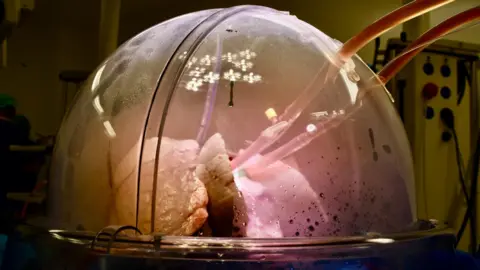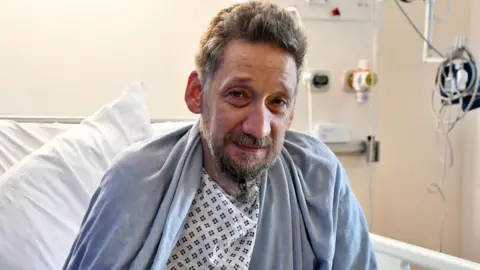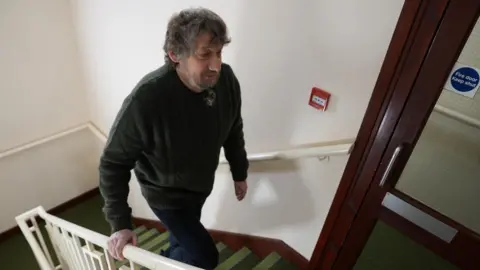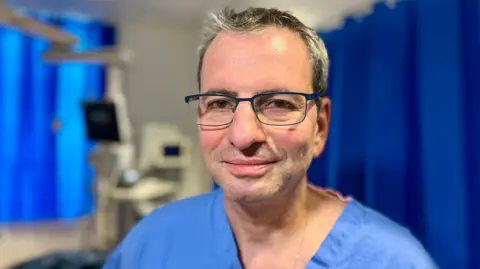 Royal Papworth Hospital
Royal Papworth HospitalSurgeons hope a new machine that keeps lungs alive outside the body could “transform” the number of people receiving transplants.
A breakthrough has been achieved at the Royal Papworth Hospital in Cambridgeshire, which was the first in the UK to pilot the use of the XPS system.
Dubbed a “lung in a box,” the machine mimics the human body and surgeon Marius Berman said it could increase the number of transplants by 30%.
Daniel Evans-Smith, 49, an event manager from Northampton, was the first person to receive a double lung transplant using the NHS system and said he was “extremely grateful”.
 Royal Papworth Hospital
Royal Papworth HospitalApproximately 81% of lungs are rejected for transplantation This is because it is inflamed or in a bad condition.
This machine improves organ health by using a ventilator to inflate and deflate the lungs. Fluids containing nutrients and oxygen are also pumped.
This technique is called extracorporeal lung perfusion (EVLP). This means that donated lungs that are considered 'borderline' for use can be regenerated and used instead of being discarded.
The organs are kept at body temperature for up to six hours.
The one-year pilot was funded by NHS England and the Royal Papworth Charity.
This machine was previously only used in research trials in the UK.
 Royal Papworth Hospital
Royal Papworth HospitalProfessor Derek Manas, director of blood and transplant medicine at the NHS, said there was “mounting evidence” that the technology could “enable more transplants by improving organ function”.
in spite of, Amendment to the law regarding consent for organ donation In 2019, the hospital announced that the machine was making the most of available lungs due to a shortage of donated lungs.
Professor Manas said more than 200 people were waiting for lung transplants, “significantly” exceeding the number of suitable donor organs.
Keeping the lungs “alive” outside the body also allows surgeons to examine the organ, increasing the chances of a successful transplant.
 Royal Papworth Hospital
Royal Papworth HospitalEvans-Smith quit smoking 12 years ago, but developed chronic obstructive pulmonary disease (COPD), a lung disease that causes breathing difficulties.
He experienced lung collapse five times and was hospitalized for a total of six months before his transplant.
As he was about to leave the hospital, nurses woke him up and told him that they had found donor lungs.
The organs were placed on ice and taken to Cambridge, where they were placed in a machine where they were “reconditioned” before being transplanted.
 David Wotowich/BBC
David Wotowich/BBCEvans-Smith said it was a “privilege of being chosen.”
“This time last year, there was a conversation in some hospitals that we needed to have a conversation about palliative care, because if we didn't start the transplant right away, I probably wouldn't survive,” he said. .
He now wants to raise money for the team that saved his life.
“Now I can run up hills without thinking. I don't have to rest when I go out or walk around town,” he said. “I can't thank them enough.”
 Nicky Fox/BBC
Nicky Fox/BBCMarius Berman, head of transplant surgery at the Royal Papworth Hospital, said he was “very proud to be the first UK hospital to use this machine” outside of clinical trials.
Other techniques exist, but surgeons say the machines are simple and patients can be trained quickly, and some alternatives require surgical teams to travel to the donor, which can be expensive. It is said that there is a sex.
He said 30 per cent of people on lung transplant lists die and Evans-Smith had “a very small window of opportunity”.
“Without the lung transplant, Daniel would not be with us today, and without the EVLP, the lung transplant would not have been possible,” he added.
The Royal Papworth Hospital carries out more lung transplants than any other center in the UK, with 41 completed last year.


